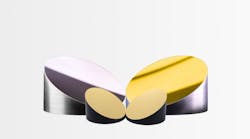Absorption coatings absorb incident light, rather than reflecting or transmitting it. Thus, they simultaneously exhibit both the low transmittance of a metal blocking filter and the low reflectance of an antireflection coating. Absorption coatings are typically used to define the aperture of an optical system where control of stray light or elimination of crosstalk is critical.
DSI ABSORPTION COATING ADVANTAGES
- Can be applied to virtually any substrate
- Available in sizes up to 200mm diameter
- High absorption/low transmittance/low reflectance
- Can be photolithographically patterned
DSI ABSORPTION COATING APPLICATIONS
- High-performance imaging systems
- Displays
- Hyperspectral sensors
THE DSI DIFFERENCE
DSI absorption coatings are distinguished by their broadband spectral performance and exceptional environmental durability (they pass the definitive MIL-STD environmental tests for adhesion, humidity and moderate abrasion). They can be designed for use anywhere from the visible through the longwave infrared spectral regions. In addition, DSI’s photolithography capability enables the production of these coatings in precise patterns ranging from circular to very complex geometries. Specifically, these can have feature sizes as small as 50μm, with ±5μm placement accuracy.
TECHNICAL INFORMATION
An absorption coating is essentially an antireflection (AR) coating placed on top of a metal coating. The AR coating efficiently couples light into the metal layer(s), which then absorbs it. However, the AR coating can be deposited on the top (external surface) of the metal layer(s), beneath it (between the metal and the substrate) or on both sides.
Placing the AR coating on the front surface of the optic (external dark mirror) makes the component appear dark when viewed from outside the optical system. This is desirable when the function of the optic is to reduce or eliminate light returned from external sources. Placing the dark mirror on the internal surface (internal dark mirror) reduces stray light within the system. This is primarily employed to eliminate crosstalk and improve system signal-to-noise ratio. An absorption coating with AR coatings on both sides (bidirectional) provides both these functionalities.
PERFORMANCE TRADEOFFS
While abosorption coating reflectance is commonly specified at less than 5%, DSI’s coatings typically reflect at much lower values. Typical transmittance specifications for DSI absorption coatings range from <1% to <0.01%. The achievable levels for a specific coating are highly dependent on the angle of incidence range as well as the wavelength range. In particular, as either the wavelength (blocking) range or the angular range increase, it becomes more difficult to keep the maximum reflectance under a specific value.


